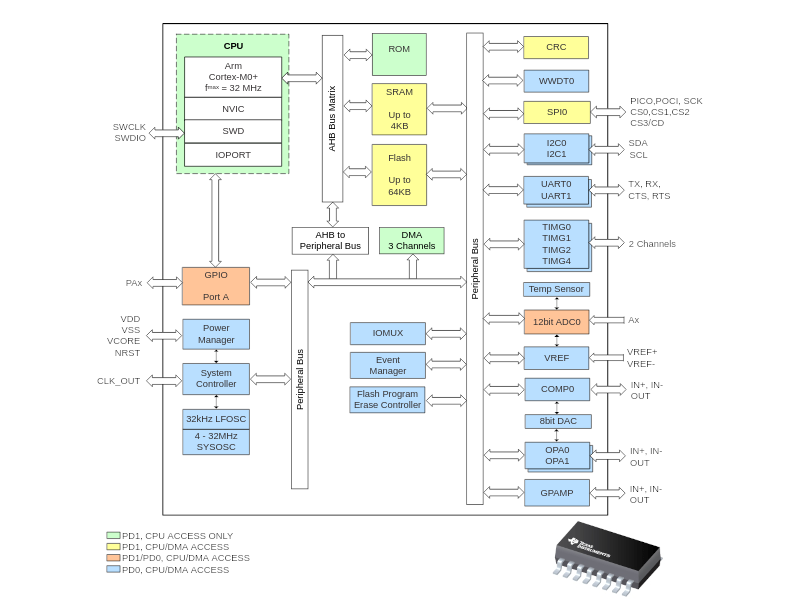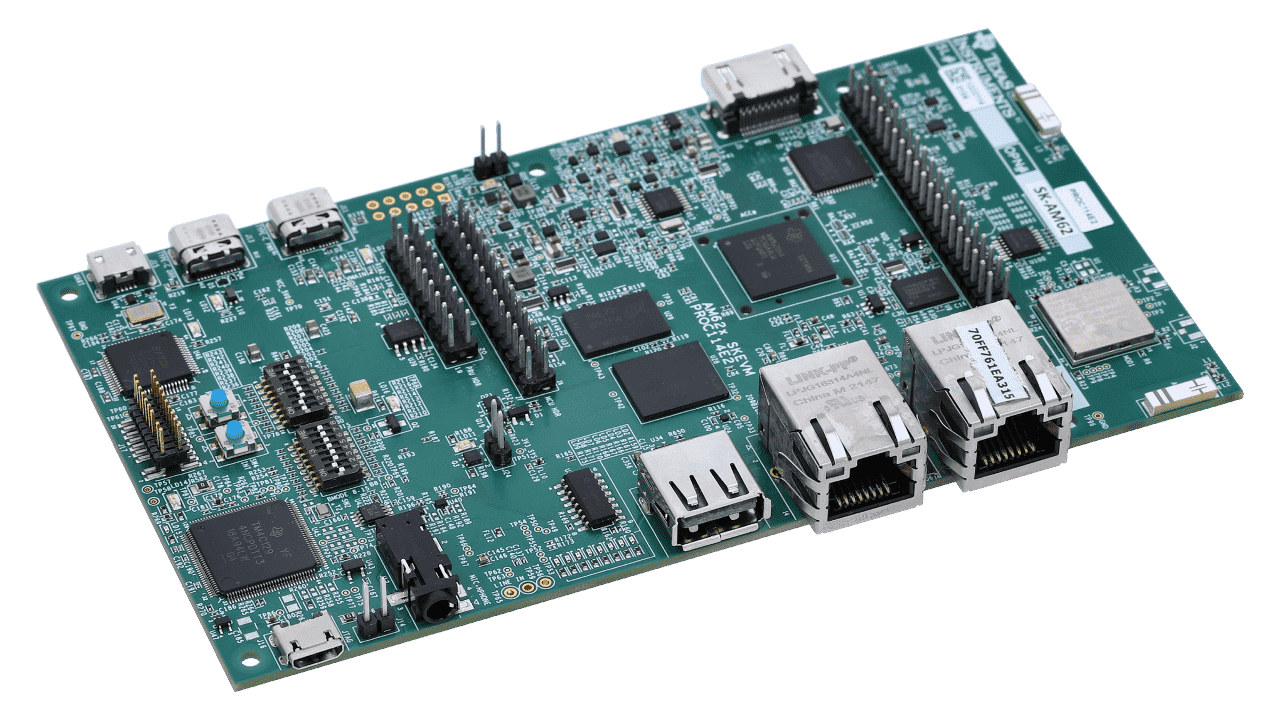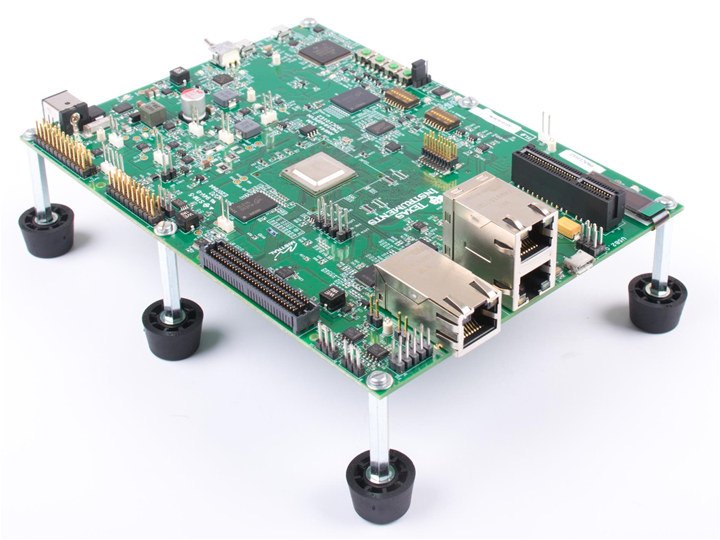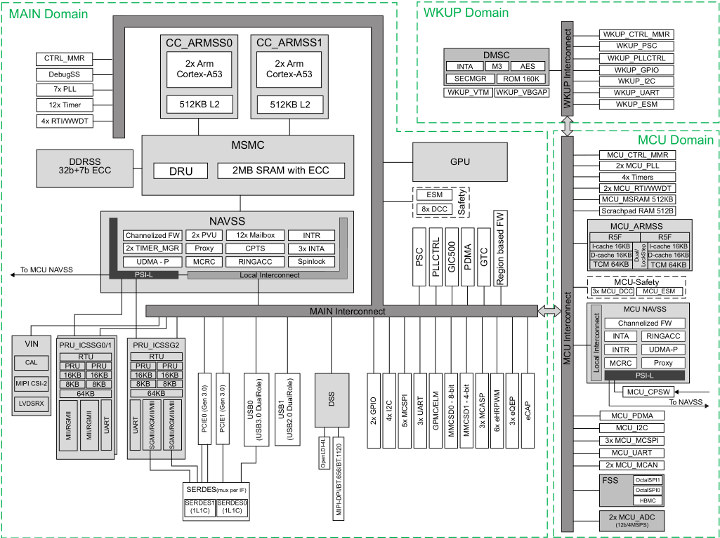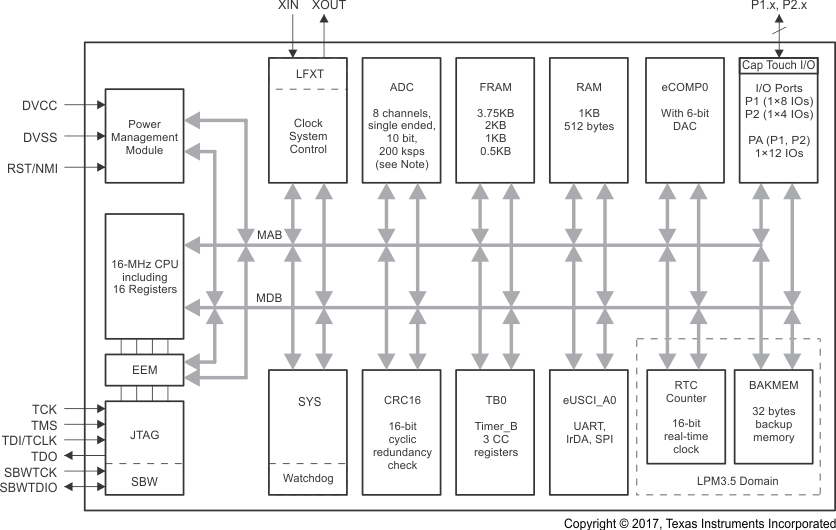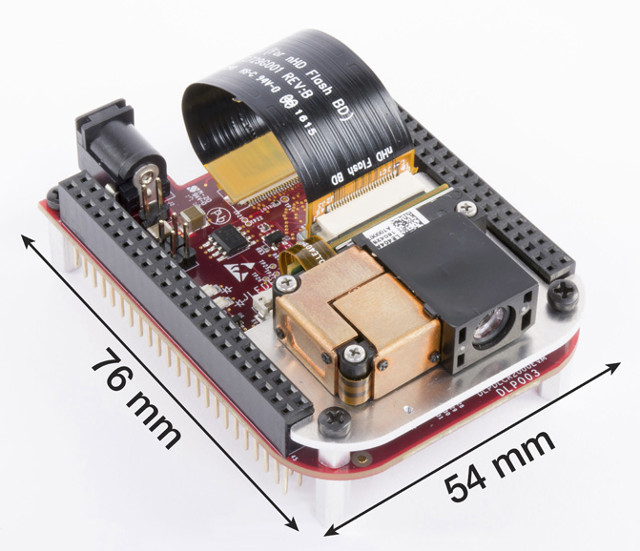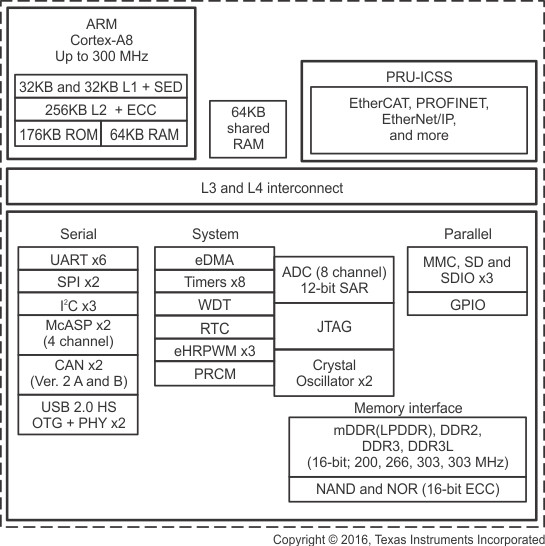Texas Instruments has just introduced its low-cost MSPM0 Arm Cortex-M0+ microcontroller portfolio comprised of the MSPM0L series with a 32 MHz CPU, up to 64 kB of flash, and 4 kB SRAM, and the MSPM0G series with an 80 MHz CPU, up to 128 kB of flash and 32 kB SRAM. Texas Instruments MSPM0L MSPM0L1306 key features: CPU – Arm 32-bit Cortex-M0+ core @ up to 32 MHz Memory – Up to 4KB SRAM Storage – Up to 64KB flash Digital peripherals 3-channel DMA controller 4x 16-bit general-purpose timers, each with two capture/compare registers supporting low-power operation in STANDBY mode, supporting a total of 8 PWM channels Windowed watchdog timer Analog peripherals 12-bit 1.45-Msps analog-to-digital converter (ADC) with up to 10 total external channels Configurable 1.4-V or 2.5-V internal ADC voltage reference (VREF) 2x zero-drift, zero-crossover chopper operational amplifiers (OPA) 1x general-purpose amplifier (GPAMP) 1x high-speed comparator (COMP) with 8-bit […]
TI unveils ULC1001 ultrasonic lens cleaning chip for self-cleaning cameras
Texas Instruments (TI) has introduced the ULC1001 digital signal processor (DSP) ultrasonic lens cleaning (ULC) technology designed – when combined with DRV2901 piezo transducer driver – for self-cleaning camera systems to quickly detect and remove dirt, ice, and water using microscopic vibrations. Cameras used in the automotive, industrial, robotics, and smart farming industries may require cleaning from time to time and that usually means manual cleaning leading to potential downtime, higher maintenance cost, and so on. It could also be done through mechanical parts but that adds further complexity to the system, so instead, Texas Instruments ULC1001 and DRV2901 combo enables cameras to rapidly self-clear contaminants using vibrations to eliminate debris. The datasheet describes the ULC1001 as a “Configurable Ultrasonic PWM Modulator With I/V Sense Amplifiers” with the following specifications: Integrated Programmable Cleaning Modes Water (expelling) Deice (melting and expelling) Mud (dehydrating and expelling) Auto-Cleaning (detecting and expelling) Custom Cleaning […]
TI Sitara AM623 & AM625 Cortex-A53 SoCs offer low-power AI for HMI and IoT applications
Texas Instruments has just launched the new Sitara AM62 family with AM623 and AM625 single to quad-core Cortex-A53 processors designed to provide IoT gateways and HMI applications with AI processing at low power, in some cases with up to 50% reduction in power consumption. The AM623 processor specifically targets Internet of Things (IoT) applications and gateways that may benefit from object and gesture recognition, while the AM625, equipped with a 3D GPU, should power HMI applications with edge AI and up to two full-HD displays. Sitara AM623 and AM625 processors Sitara AM623/AM625 key features and specifications: CPU – Single, dual, or quad-core Arm Cortex-A53 processor @ up to 1,400 MHz with 512KB L2 shared cache, plus 32KB I+D cache per core Co-processor – 1x Arm Cortex-M4F real-time core at up to 400 MHz with 256KB SRAM with SECDED ECC GPU (AM625 only) – Unnamed 3D GPU with support for OpenGL […]
TI AM64x 7-core processor is made for PLC’s, motor drives, industrial robots
Texas Instruments AM64x is a family of 64-bit Arm processors with functional safety designed for Programmable Logic Controllers (PLC), motor drives, remote I/O, and industrial robots. The top-end processor of the family, AM6442, comes with seven cores including two Cortex-A53 application cores, four Cortex-R5F real-time cores, and one Cortex-M4F isolated core. AFAICT, while the documentation is dated January 2021 and TI announced the processor in February in a blog post with a cryptic title, it was only first picked up by Embedded Computing in early May. Besides the processor itself, TI also provides an AM64x starter kit and a full-featured AM64x evaluation kit, and several companies are already preparing development boards and modules as we’ll see further below. TI AM64x processor AM64x key features & specifications: CPU cores Dual-core Arm Cortex-A53 processor @ 1.0 GHz with 256KB L2 shared cache with SECDED ECC, 32KB L1 D-cache, 32KB L1 I-cache Up […]
Texas Instruments To Finally Launch a 64-bit Processor with AM654 SoC
Texas Instruments has a wide portfolio of Arm-based processors targeting industrial control with their Sitara family. So all their models, including the latest Sitara AM57x family, were based on 32-bit Arm cores. But a somewhat recent Linux mainline kernel commit reveals the company has been working on a 64-bit Arm processor family, namely AM65x family, and one the first processor will be TI AM654 “Keystone III” quad-core Arm Cortex-A53 + dual lockstep Cortex-R5F processor. The AM654 SoC is said to be a lead device of the K3 multicore SoC architecture targeting both the broad market and industrial control. Some of the key features and specifications include: CPU – Quad ARMv8 A53 cores split over two clusters GPU – PowerVR SGX544 GICv3 compliant GIC500 Configurable L3 Cache and IO-coherent architecture Dual lock-step capable R5F uC for safety-critical applications High data throughput capable distributed DMA architecture under NAVSS 3x Gigabit Industrial Communication […]
Texas Instruments MSP430 Value Line Sensing MCUs Sell for 25 Cents and Up
Texas Instruments MSP430 16-bit mixed signal microcontroller has been around since at least 2004, and the last time I played with the MCU was with eZ430-Chronos wireless watch development kit in 2011. Over the years, the company has added more parts to its MSP430 MCU portfolio, and they recently added two new MSP430 Value Line Sensing MCUs that offer up to 25 functions (timers, I/Os, reset controller, EEPROM…) for as low as 25 cents, as well as a new MSP430FR2433 LaunchPad development kit . MSP430FR2000 and MSP430FR2100 MCUs have the same features set, except for the memory (512 vs 1024 bytes): 16-Bit RISC Architecture up to 16 MHz Memory / Storage MSP430FR2000 (new) – 0.5KB of Program Ferroelectric RAM (FRAM) + 512 Bytes of RAM MSP430FR2100 (new) – 1KB of Program FRAM + 512 Bytes of RAM MSP430FR2111 – 3.75KB of Program FRAM + 1KB of RAM MSP430FR2110 – 2KB of Program FRAM + 1KB of RAM Supply Voltage […]
DLP LightCrafter Display 2000 EVM Adds a Pico Projector to BeagleBone Black for $99
Back in 2012, Texas Instruments introduced DLP LightCrafter pico projector evaluation module powered by a TMS320DM365 ARM9 processor @ 300 MHz running embedded Linux, and selling for $599. Since then, we have seen many products including projectors based on DLP technology such as standalone tiny projectors, Windows mini PCs, Android TV boxes, tablets, an even light bulbs. However, so far I can’t remember seeing any easy way to easily integrate DLP projector with the cheap ARM Linux development boards available today. Texas Instruments has now filled that void with DLP LightCrafter Display 2000 EVM that adds a pico-projector to BeagleBone Black (or Green) based on the new 0.2″ DLP2000 DMD (Digital Mirror Device) chip. The board is comprised of two subsystems: Light engine (top) with the optics, red, green, and blue LEDs, and the 640 × 360 (nHD) DLP2000 DMD configured to deliver around 20 lumens by default (this can […]
Texas Instruments Announces AMIC110 Sitara Industrial Communication Processor & Development Board
Texas Instruments Sitara AM335x SoCs integrate an ARM Cortex A8 processor @ up to 1GHz with a PRU-ICSS for industrial communication, but also include a display controller, an optional PowerVR GPU, and a rich-set of peripherals making it useful for a wide range of applications. The company has now launched AMIC110 Sitara processor with a Cortex A8 core @ 300 MHz, and a PRU-ICSS specifically designed for industrial Ethernet, and fieldbus communication. Texas Instruments AMIC110 Sitara processor key features and specifications: CPU – ARM Cortex-A8 processor @ up to 300 MHz with NEON, 32+32KB I/D cache, 256KB L2 cache, 176KB boot ROM, 64KB RAM External Memory Interfaces (EMIF) – mDDR(LPDDR), DDR2, DDR3, DDR3L Controller up to 1GB General-Purpose Memory Controller (GPMC) – 8-bit & 16-bit Asynchronous Memory Interface with up to Seven Chip Selects (NAND, NOR, Muxed-NOR, SRAM) 2x programmable Real-Time Unit Subsystem and Industrial Communication Subsystem (PRU-ICSS) supporting EtherCAT, […]


